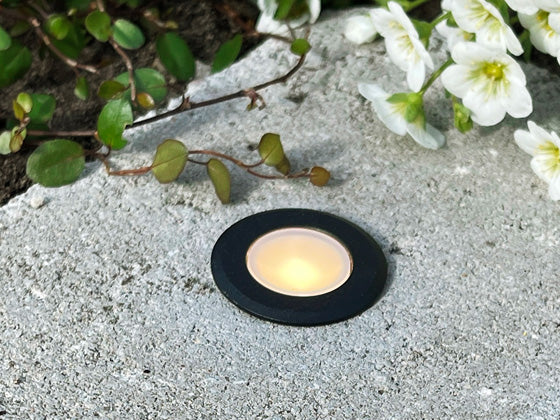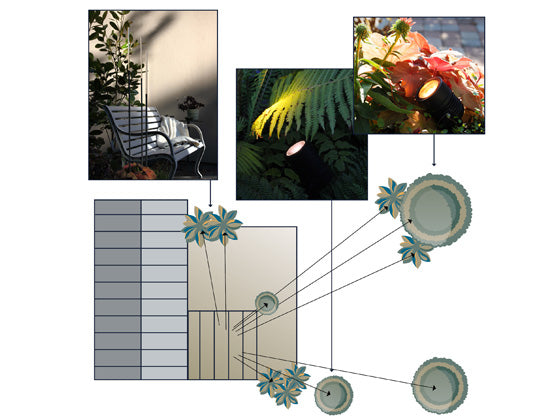Lumen, beam angle, volt & watt
What it all boils down to when it comes to the selection of lamps for your garden?
When planning the lighting for your garden you are probably most interested in the functionality of the light, how it will enhance and highlight for example your plants or trees. Let us dig into the subject at hand to better understand what to keep in mind when reading the specifications for the lamps you plan on ordering. We will be looking over the most important features here.

Lumen and beam angle
To put it simply, when you choose a lamp you first need to look at two things. Lumen and the beam angle. The interaction decides how the light will be perceived. There are naturally additional factors that play a role in the end result that we do not touch in this article, for example how much light is already present or how thick the vegetation is that you want to illuminate.
Lumen is an indicator of how much light the lamp (light source) actually generate. The higher the lumen, the brighter the light. This is of course something that is measured in a controlled environment and will therefore be perceived differently by your eyes in your garden, but it does give you a good baseline on what to expect and what lamp to choose..
If you are going to light up a pathway, you will probably need a wide beam angle to see where you walk but also for the light not to be blinding. On the other hand, if you would like for the light to instead reach the top of a tall pine tree, you would want a more narrow beam angle, so the light focuses on one point and reaches all the way to the top. This means that two different lamps, with the same lumen, are experienced differently due to how the light is spread over the surface it is intended to illuminate. A very important distinction.
The most common beam angle is around 30-40° when it comes to garden lights. Anything below can be considered narrow and anything above is considered wide.
Simple guideline
If you illuminate a medium-sized tree with a medium-sized crown with a lamp that has a beam angle of 35°, then 300-400 lumen will in most cases be adequate. If you want a more narrow beam angle but weaker perceived light, a lamp with lower lumen will achieve this. If you want a wider light but the same feeling of brightness, then upping the lumen is the best way of achieving it.
If this all seems tricky, take a look at the illustration below and use our spotlight guide to choose the perfect lamp for your needs.
Download the spotlight guide here

Watt
You can forget everything you learned about watt and lamps now. Well maybe not, but watt does not have anything to do with how you experience the light. That was also the case in the past, but watt and lumens were almost directly correlated when we had light sources with traditional filaments. Someone made a mistake in the beginning of time and now it is time to set things straight. Ever since LEDs came into the picture, lumen and watt stopped being directly correlated. This is due to LEDs being a completely different technology and is still evolving as manufacturers are continuously getting more and more light out of every watt. Watt and lumen are just not the same anymore. It is simply not possible to say that a 40-watt lightbulb is the same as a 5-watt LED. "Huh??" you may think to yourself. We are not going to make it any more complicated and make it academic. We want you to succeed with your gardening project, nothing else.
Watt is simply put what effect the lamp has. Watt is only really important after you have found the lights you will have in your garden. You add up the total wattage and then choose the corresponding transformer. That's it! You don't have to think in terms of watt from now on. It is clear that a 2-watt lamp gives less light than a 10-watt lamp, but the perceived light is the interaction between the lumen and the beam angle.
Volt
Volt is the voltage of electricity. The electrical sockets in our homes are 230 volts. Most of us don't think about it in our day-to-day life. There are wall sockets where we plug in our products that need electricity. Most garden lights today are made for 12 or 24 volts. What this means is that you cannot plug one of our lamps directly into your wall socket in the house without having something in between that converts the voltage correctly and safely. This "something" is called a transformer.
A 12-volt system is safer to have in the garden than a 230-volt system and can also be installed and maintained without having to be an authorized electrician. You therefore save a lot of money by being able to create a wonderfully lit garden on your own. There are also no requirements to bury the cables underground and you will be fine if, unluckily, you happen to cut a cable with the showel.
Everything you need to consider when choosing our products
The voltage for our lamps is 12 volts. This means that you can install the lights in your garden yourself. However, you need a transformer that converts your 230V household electricity to 12V.
Watt is important to keep in mind when choosing the size of a transformer. Calculate the wattage of the lamps and choose a transformer accordingly. Keep in mind that if you want to expand your system later on, you need to prepare for it with spare capacity in the transformer. In addition, leave 15% of the transformers capacity unused for optimal life length. In short, we recommend choosing a transformer with a higher capacity than you need. It is likely that you will need the extra wattage later on.
Lumen and the beam angle determine how the light will be experienced. The higher the lumen and the more narrow the beam angle, the stronger the light is experienced. A wider light is perceived softer. If you are unsure, some retailers have loaner boxes that you can take home to test. Or why not get the help of a garden designer or light designer for a really professional result?
Find your nearest retailer or light designer





